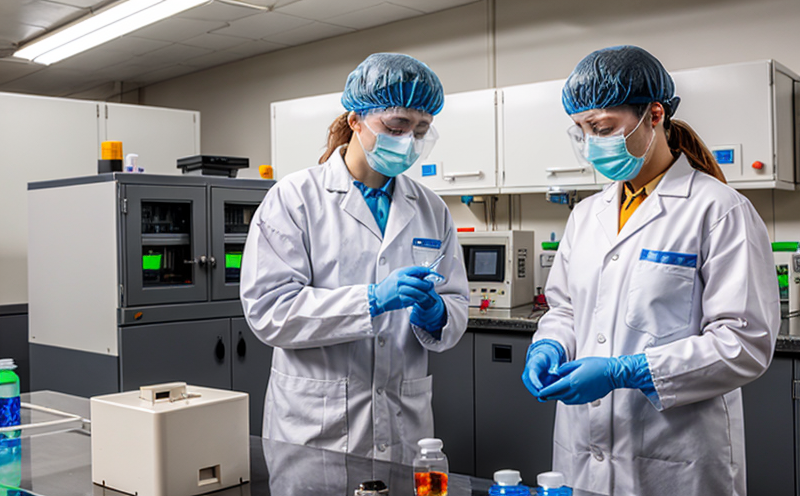EN 19203 PAH Multi-Class Screening in Meat Products
The European Standard EN 19203 is a multi-class screening method specifically designed to assess polycyclic aromatic hydrocarbons (PAHs) in meat products. This standard ensures that food safety and quality are maintained by providing a standardized approach for the detection of PAHs, which can arise from various sources such as processing, storage, or cooking methods.
PAHs are carcinogenic compounds known to form during the incomplete combustion of organic materials. In meat products, they may be introduced through the smoking process, grilling, or even during the curing and drying processes if done incorrectly. The European Union has set strict limits on PAH concentrations in food to protect public health.
The EN 19203 standard covers a wide range of meat products including beef, pork, lamb, poultry, and processed meats like sausages, bacon, and ham. By using this method, laboratories can efficiently screen large batches of raw materials or finished goods without the need for extensive sample preparation, thus saving time and resources.
The standard specifies a two-step approach to PAH screening: initial extraction followed by instrumental analysis. The extraction process involves dissolving the samples in an appropriate solvent before chromatographic separation and detection using either high-performance liquid chromatography (HPLC) or gas chromatography coupled with mass spectrometry (GC-MS). This dual method ensures both sensitivity and specificity, making it suitable for detecting multiple PAH compounds simultaneously.
The acceptance criteria for this standard are based on the maximum allowed levels of individual PAHs specified by EU regulations. For instance, benzo[a]pyrene should not exceed 5 μg/kg in meat products. Compliance with these limits is crucial as non-compliance can lead to product recalls and legal penalties.
By implementing EN 19203, laboratories demonstrate their commitment to food safety and regulatory compliance. This method allows for rapid identification of potential hazards early in the production process, enabling companies to take corrective actions promptly if necessary. It also supports continuous improvement initiatives aimed at enhancing product quality and consumer trust.
Using this standard provides several advantages beyond mere regulatory adherence. It helps maintain brand reputation by ensuring consistent product quality across batches. Moreover, it facilitates better decision-making regarding ingredient sourcing and processing parameters. Lastly, it enhances overall operational efficiency through streamlined testing procedures.
Benefits
The implementation of EN 19203 PAH Multi-Class Screening in Meat Products offers numerous benefits to stakeholders within the food industry:
- Enhanced Safety: Ensures that meat products meet stringent safety standards set by EU regulations, thereby protecting consumers from harmful PAH exposure.
- Efficient Quality Control: Allows for quick identification of issues during production, enabling timely corrections and minimizing waste.
- Brand Protection: Maintains brand integrity by consistently delivering high-quality products that meet or exceed customer expectations.
- Operational Efficiency: Simplifies testing processes through standardized methods, reducing processing time and costs associated with manual tasks.
- Regulatory Compliance: Facilitates adherence to international standards and local laws, avoiding potential fines and sanctions.
- Consumer Confidence: Builds trust among customers by assuring them of the safety and quality of purchased meat products.
In summary, adopting EN 19203 not only meets regulatory requirements but also strengthens a company's position in the competitive market. It fosters long-term relationships with suppliers, distributors, and retailers while enhancing overall business performance.
Competitive Advantage and Market Impact
Implementing EN 19203 PAH Multi-Class Screening offers significant competitive advantages that can positively impact a company's market presence:
- Differentiation in the Marketplace: Companies that adhere to this standard demonstrate their commitment to quality and safety, setting them apart from competitors who may not follow similar practices.
- Better Negotiations with Suppliers: By ensuring supplier compliance with EN 19203, buyers can negotiate more favorable terms since suppliers are likely to prioritize working with reliable partners.
- Innovation Opportunities: Adhering to such rigorous standards encourages innovation in processing techniques and ingredient selection, leading to improved product offerings.
- Increased Market Share: Satisfied customers are more likely to become repeat buyers or recommend products to others, potentially expanding market share.
- Potential for New Markets: Compliance with international standards opens doors to exporting goods into new markets where stringent food safety regulations apply.
In an increasingly globalized and regulated environment, companies that prioritize compliance with EN 19203 will find themselves better positioned to thrive in both domestic and foreign markets. This strategic approach not only enhances operational efficiency but also contributes significantly to long-term sustainability goals.
Use Cases and Application Examples
The application of EN 19203 PAH Multi-Class Screening is versatile and applicable across various scenarios within the meat processing industry:
- New Product Development: Ensures that newly developed meat products meet all necessary regulatory requirements before launch.
- Routine Quality Control: Provides regular checks on ongoing production batches to maintain consistent quality standards.
- Batch Acceptance: Verifies the safety of incoming raw materials from suppliers before processing into final products.
- Process Optimization: Identifies potential areas for improvement in existing manufacturing processes by pinpointing sources of contamination.
- Recall Prevention: Helps prevent product recalls by identifying and addressing issues early in the production cycle.
An example use case involves a major poultry processor who uses this method during their quality control checks. They found that certain batches of smoked chicken had higher than acceptable levels of benzo[a]pyrene, prompting them to adjust smoking parameters accordingly. This proactive measure prevented any affected products from reaching consumers and earned the company praise for its commitment to food safety.
Another instance includes a large supermarket chain conducting routine checks on all meat suppliers. By ensuring that each supplier adheres to EN 19203, they maintain confidence in their supply chain and offer safer options to their customers.





